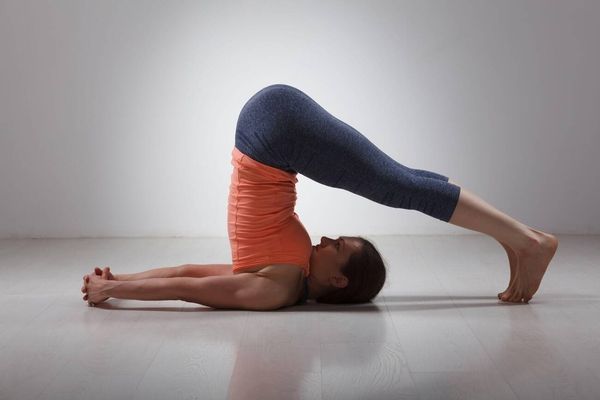Exploring Ardha Halasana: Journey into the Half Plow Pose
Ardha Halasana, or the Half Plow Pose, is a gentle yet profound yoga posture that beckons practitioners into the depths of their physical and mental endurance. Rooted in the ancient wisdom of yoga, this asana serves as a bridge between the earth and the sky, the physical and the ethereal. Its name, derived from Sanskrit, where “Ardha” means “half,” “Hala” means “plow,” and “Asana” means “pose,” beautifully encapsulates the essence of this transformative posture. As we delve into Ardha Halasana, we embark on a journey that stretches beyond mere physical flexibility, touching the soul’s infinite potential for growth and enlightenment.

Steps to Perform Ardha Halasana
Embarking on the journey of Ardha Halasana requires mindfulness and patience. Here’s how to cultivate this serene posture:
- Initial Preparation: Begin by lying flat on your back on a comfortable yoga mat, arms by your sides, palms facing down.
- Entering the Pose: Inhale deeply and, as you exhale, gently lift your legs off the floor to a 90-degree angle. Support your hips and lower back with your hands, keeping your elbows on the ground.
- Alignment and Execution: Continue to lift your hips off the floor, bringing your legs over your head until they are parallel to the ground. Your legs should be straight, but if you’re a beginner, a slight bend in the knees is acceptable to ease into the position.
- Breathing: Maintain steady, deep breaths. The focus on your breath helps deepen the pose, enhancing its benefits.
- Exiting the Pose: Gently lower your legs back down to the starting position, releasing your hands and allowing your spine to roll down slowly, one vertebra at a time.
Benefits of Ardha Halasana
The Half Plow Pose is a treasure trove of benefits, offering not just physical but also mental and emotional rejuvenation:
- Physical Wellbeing: Ardha Halasana stretches the spine, shoulders, and hamstrings, improving flexibility and relieving tension. It stimulates the abdominal organs, aiding digestion, and boosts circulation to the upper body.
- Mental Clarity: By calming the mind and reducing stress, this asana encourages a state of mental well-being, preparing the practitioner for meditation and deepened focus.
- Emotional Balance: The gentle inversion of this pose helps soothe the nervous system, reducing anxiety and promoting a sense of inner peace and emotional stability.
Tips for Beginners
Embarking on any new yoga pose can be both exciting and daunting. Here are some tips to make your journey into Ardha Halasana smoother and more enjoyable:
- Warm-Up: Begin with gentle stretches to prepare your body. Poses like Paschimottanasana (Seated Forward Bend) and Bhujangasana (Cobra Pose) can help loosen the spine and hamstrings.
- Use Props: If you find it challenging to support your back, consider using a folded blanket or a yoga block under your hips for added support.
- Listen to Your Body: Yoga is about union and harmony, not pushing your limits to the point of discomfort. If you feel any strain, especially in your neck or back, gently come out of the pose.
Common Mistakes to Avoid
Awareness of common pitfalls can significantly enhance your practice and prevent potential injuries:
- Overarching the Neck: Ensure your neck is not strained or overly arched. The weight should be distributed evenly across the shoulders, not on the neck.
- Rushing into the Pose: Gradual entry into and exit from Ardha Halasana is crucial. Avoid jerky movements that can shock the body.
- Ignoring Pain: While mild discomfort is normal as you stretch, sharp pain is a sign to stop. Yoga should never cause pain, and respecting your body’s limitations is key to a sustainable practice.
Ardha Halasana is more than just a physical posture; it’s a gateway to deeper self-awareness and a testament to the enduring power of yoga to harmonize the body, mind, and spirit. As beginners, the journey into Ardha Halasana might seem challenging, but it’s also filled with opportunities for growth and transformation. By approaching this pose with patience, respect for your body’s limits, and an open heart, you’ll unlock not only the physical benefits but also the profound emotional and mental clarity that yoga offers.